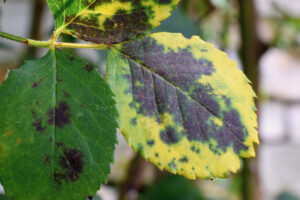Identify the Cause of Black Spots
Learn how to get rid of black spot. To effectively address black spots in your garden, it’s crucial to first identify whether they are caused by fungal ailments like black spot disease, especially common in roses. This disease is identifiable by the circular, fringed edges and dark coloration of the spots on leaves. Additionally, evaluate your plants for symptoms of pest infestations, such as the presence of insects or irregular spots, which might indicate damage rather than disease. Lastly, consider the possibility of nutrient deficiencies; yellowing leaves with darker spots may suggest a lack of essential minerals.
Implement Good Gardening Practices
Once the cause is determined, it’s important to implement good gardening practices. Begin by meticulously removing and disposing of all infected leaves and garden debris, as these can harbor fungal spores that spread the disease. When watering, aim for the base of the plants to keep foliage dry; wet leaves can create an ideal environment for fungi to flourish. In addition, ensure there’s enough space between your plants to promote proper air circulation. This helps reduce humidity around the foliage, further minimizing the risk of black spot disease and other fungal infections.
Natural Remedies for Treatment for Black Spot
Exploring natural remedies can be an effective and eco-friendly way to combat black spot disease. One such solution involves mixing baking soda with water to create a homemade fungicide. To prepare it, dissolve one tablespoon of baking soda in a gallon of water, and add a small amount of liquid soap to help the mixture adhere to the leaves. Spray this solution on the affected foliage, taking care to cover both the tops and undersides of the leaves. This treatment can alter the pH on the leaf surface, making it less hospitable to fungi.
Another excellent organic option is neem oil, which boasts both fungicidal and insecticidal properties. Neem oil is derived from the seeds of the neem tree and can be applied to plants to not only deter fungal diseases like black spot but also to manage pest populations. When using neem oil, follow the product’s instructions for dilution and application, typically involving a spray to the affected areas. Regular treatment with neem oil can help protect your garden against a myriad of issues, promoting healthier plants and a more thriving garden ecosystem.
Chemical Treatments for Black Spot
While natural remedies are often preferred for their eco-friendliness, some gardeners may turn to chemical treatments as a last resort when dealing with severe or persistent black spot disease. Selecting the right fungicide is crucial, and products containing chlorothalonil or myclobutanil can be particularly effective against black spot. It’s imperative to strictly follow the manufacturer’s instructions regarding dilution, application frequency, and safety measures. Typically, this involves thoroughly spraying the infected plants, ensuring both the tops and undersides of the leaves are coated, and repeating the treatment according to the recommended schedule. Always wear protective gear and avoid application during windy conditions to protect yourself and prevent drift to other areas.
Preventative Measures for Black Spot
Preventative measures are key in controlling black spot disease. One of the most effective strategies is to choose disease-resistant plant varieties for future planting. These varieties have been bred to be less susceptible to fungal infections, including black spot, which can save time and resources in the long run. When selecting new plants, research or consult with a local nursery to determine which varieties are known for their resistance to black spot. By prioritizing these plants in your garden, you can build a first line of defense that helps mitigate the possibility of disease outbreaks.
Regular and balanced fertilization plays a pivotal role in maintaining the health of garden plants. A well-nourished plant is often more resistant to diseases like black spot. Gardeners should establish a fertilization schedule that meets the nutritional needs of their plants without overfeeding, which can lead to excessive leaf growth at the expense of overall plant health.
Mulching
Applying mulch is an effective strategy to reduce the risk of black spot spores splashing onto plant leaves. A layer of organic mulch, such as wood chips or straw, can act as a barrier between the soil and the plants. This not only helps to keep the foliage dry but also contributes to soil health by retaining moisture and temperature, reducing weed competition, and slowly adding nutrients back into the soil as it decomposes. When mulching, be sure to leave some space around the base of the plants to prevent moisture buildup and ensure proper air circulation.
Conclusion
In conclusion, black spot can be a challenging disease to manage in the garden, but there are several preventative measures that gardeners can take to minimize its impact. By selecting disease-resistant plant varieties, fertilizing appropriately, and applying mulch, gardeners can create an environment that is less conducive to black spot growth and spread. However, if a plant does become infected with black spot, it is important to promptly remove any infected leaves and implement proper cultural and chemical control methods to prevent further spread. By following these precautions, gardeners can enjoy healthy and vibrant plants without the threat of black spot looming over their gardens.
So don’t let black spot discourage you from gardening, instead use it as an opportunity to learn and improve your techniques for maintaining a healthy garden. With proper care and management, you can ensure that your plants stay strong and beautiful all season long. Happy gardening! So let’s get out there and enjoy the beauty of nature in our own backyard while also keeping diseases like black spot at bay. Keep these tips in mind and your garden will be thriving in no time! Remember to always keep an eye out for any signs of black spot, and if you do notice it, take action immediately to prevent further spread. Your plants will thank you for it! And most importantly, have fun in your garden and don’t let worries about diseases like black spot dampen your gardening experience. With the right techniques and care, you can maintain a healthy and beautiful garden all year round. So keep gardening and enjoy the beauty of nature! As always, happy gardening! Keep learning, experimenting, and enjoying all that gardening has to offer. Remember that even though black spot may be a common problem for gardeners, it is not unbeatable. With diligence and proper care, you can successfully prevent and manage black spot in your garden.


